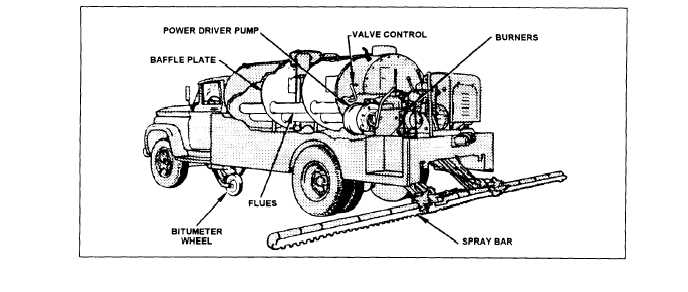lifted and the aggregate on it is weighed. This will give
the weight per square yard of aggregate being spread.
ASPHALT DISTRIBUTOR
The asphalt distributor (fig. 16-33) is a unit
consisting of an insulated storage and heating tank, an
open flame heating system, an asphalt pump, a
low-pressure air blower, and a circulating and spraying
system. Power to operate the components is PTO
driven.
NOTE: The operation of this truck requires the
absolute need for experienced personnel only. Mishaps,
resulting in loss of man-days and equipment, are a direct
result of this factor being overlooked.
Heating System
The air blower provides low-pressure air to atomize
fuel for the burners. The burners heat the tubes, located
in the tank. An asphalt covering must be maintained
over the fire tubes to prevent them from overheating and
causing a fire or explosion. Because the distributor is
mobile, care must be taken to ensure that heating is
performed in a level area that is well-ventilated and that
the distributor truck is not moving at all and is at a
COMPLETE HALT. Whenever you are heating
cutbacks, the asphalt must be circulating at all times.
This is a must to prevent any chance of volatile liquids
overheating around the flues, which can be very
dangerous.
Spray System
The spray system consists of necessary piping, a
series of hand-operated valves to control the flow of
bitumen, and an adjustable length spray bar, capable of
providing coverage from 4 to 14 feet wide. The spray
bar may be the full-circulating or the noncirculating
type, depending on the model of the distributor. The
spray bar may be equipped with either 1/8-inch nozzles
or 3/8-inch nozzles; the 1/8-inch nozzles are used for
most applications. The application rate is controlled by
the length of the spray bar, the pump output, and the
forward speed of the distributor truck.
Spray Bar Adjustments
For normal use, the spray bar of the distributor
should be adjusted, so the vertical axes of the nozzles
are perpendicular to the roadway. Also, each nozzle on
the spray bar should be set at the same angle. The angle
set for each should be between 15 degrees to 30 degrees
of the horizontal axis of the spray bar (fig. 16-34) or
according to manufacturer’s specifications. This action
prevents the fan-shaped spray patterns of the nozzles
from interfering with each other.
Another adjustment that is essential for uniform
prime or tack coat coverage is the adjustment of the
height of the spray bar. As shown in figure 16-35, the
fan-shaped spray patterns from the nozzles overlap to
different degrees, depending on the distance between
the spray bar and the surface to be covered. The spray
bar should be set high enough, usual] y 10 to 12 inches
above the roadway for the surface to receive triple
Figure 16-33.-Asphalt distributor.
16-28


